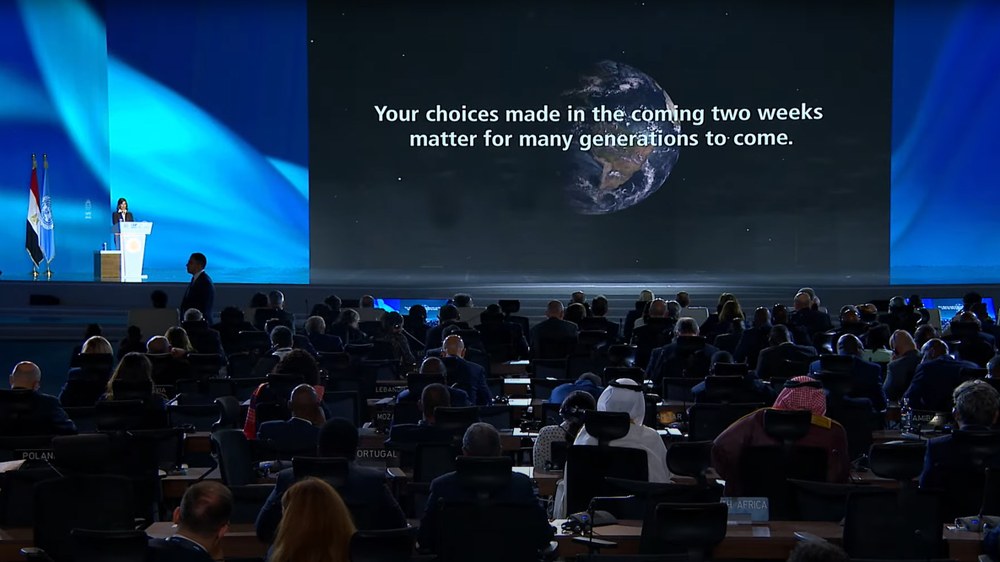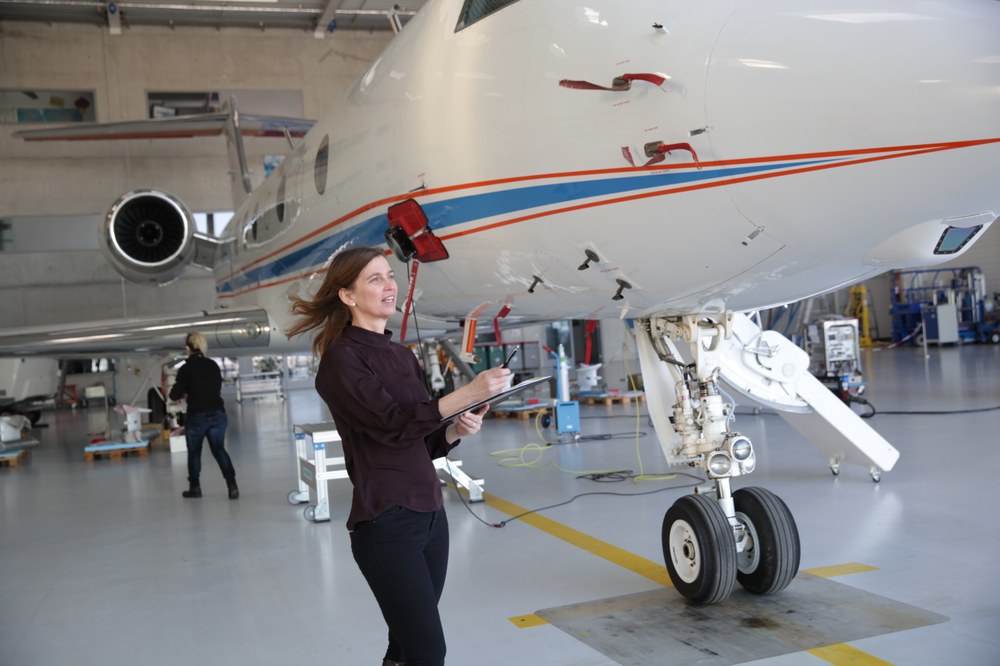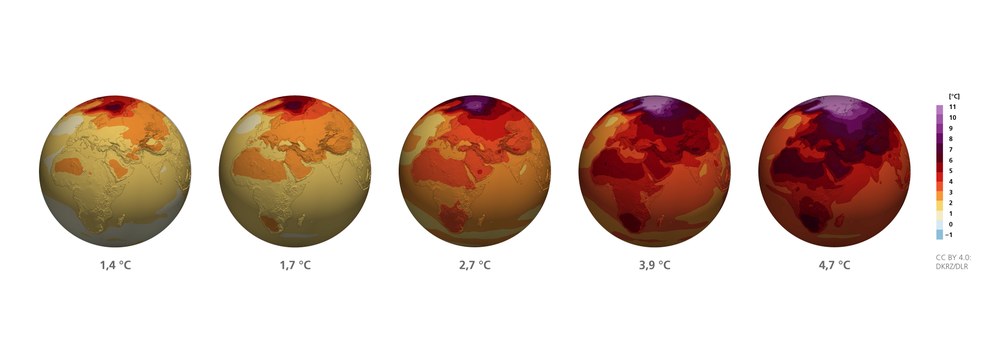Without a doubt

"Recent climate change is unprecedented. We all know and feel this." There's no doubt in Veronika Eyring's words. Research findings irrefutably demonstrate how the climate is changing, and the accuracy of the projections made using climate models is always improving. Eyring's research is contributing to this. The scientist leads the Earth System Model Evaluation and Analysis department at the DLR Institute of Atmospheric Physics. There, teams use climate models to look into the past and future of Earth's climate.
In November 2022, Veronika Eyring gave an invited speech in front of heads of state and negotiators at the opening session of the UN Climate Change Conference (COP27). Using scientific data, she presented climate change, its causes and its consequences. As part of her speech, she highlighted that the concentration of greenhouse gases in the atmosphere has reached record levels; in fact, carbon dioxide has increased by 50 percent compared to pre-industrial times. "As a consequence, global warming has reached 1.1 degrees Celsius above pre-industrial levels," explained Eyring at the conference in Egypt. These numbers are worryingly close to the 1.5 degrees Celsius target agreed upon at the UN Climate Change Conference in Paris in 2015. The results come from the latest report of the Intergovernmental Panel on Climate Change (IPCC), to which researchers from around the world contribute.
"In every region of the world, we are seeing out-of-control climate impacts with extreme events becoming more frequent and more severe. Many of the recent extremes would have been highly unlikely to occur without human induced climate change."
Veronika Eyring, Head of the Earth System Model Evaluation and Analysis department at the DLR Institute of Atmospheric Physics
The report's statements are as relevant as ever: "The warming we have observed since 1850 is not caused by natural events. It is caused by human activities emitting carbon dioxide and other greenhouse gases also causing widespread, rapid and intensifying climate changes across the entire Earth system, which will increase with any additional further warming." This sentiment was reinforced by Eyring as she highlighted the findings of the scientific teams, before receiving a standing ovation from the previous speaker, Al Gore. The scientist, Nobel Peace Prize winner and former US Vice President sat next to Eyring and shook her hand as she left the stage. Did they engage in conversation? "The opportunity for direct exchange with politicians at different levels was certainly an intensive part of the COP experience," she recalls.

The time for action is now!
Veronika Eyring has been conducting research at DLR in Oberpfaffenhofen for more than 20 years and has been a Professor of Climate Modelling at the University of Bremen since 2017. Two years ago, the German Research Foundation (DFG) awarded her the Leibniz Prize for her significant contributions to improving the understanding and accuracy of climate projections. Eyring is an authority in her field, and her statements leave no room for doubt. "In every region of the world, we are seeing out-of-control climate impacts with extreme events becoming more frequent and more severe. Many of the recent extremes would have been highly unlikely to occur without human induced climate change," she said at COP27. "The time for action is now."
At the end of COP27, the German government announced that it found the results of the conference disappointing, particularly those related to reducing global greenhouse gas emissions. "The gap we have to close in order to limit warming to the target of 1.5 degrees Celsius is still very wide indeed, and some states have blocked any attempt to close it even a little," said Federal Minister for Foreign Affairs of Germany, Annalena Baerbock. A global shield against climate risks initiative was launched in response, with the aim of helping people affected by climate damage – primarily those in less developed and more vulnerable countries.

DLR provides essential Earth observation data
Much time has now passed since COP27, and Eyring has returned to her everyday research. "Under our current understanding, and if no additional measures are decided and implemented, global warming is projected to reach 2.8 degrees Celsius," she says. "To limit it to 1.5 degrees Celsius, we need to cut carbon dioxide emissions by approximately 45 percent by 2030. That's in seven years. And they must continue to fall to reach net zero by 2050. Carbon dioxide emissions would then have to be negative for the rest of the century." Even limiting warming to two degrees Celsius by the end of the century will require similarly drastic reductions. A diagram, scaled from blue to orange and red to purple, illustrates the warming effect: the globe is turning orange, red and even purple almost everywhere.
Meanwhile, the computer models used to project climate change are becoming increasingly accurate. They are now capable of processing vast quantities of data, evaluating this information and linking it together to form an overall picture of the climate system. Eyring uses Earth observation data and artificial intelligence (AI) methods to obtain more reliable climate projections. DLR has the necessary experience from decades of Earth observation. And it has the infrastructure to carry out the analyses.

The DLR Institute of Atmospheric Physics in Oberpfaffenhofen, together with over 70 international research institutes, is in charge of developing the Earth System Model Evaluation Tool (ESMValTool), which is helping to present the results of climate model simulations. This computational tool allows a comprehensive evaluation of the climate and Earth system models in comparison with observational data. CMIP (Coupled Model Intercomparison Project), which was started more than 25 years ago, is a project in which climate models are compared with each other. CMIP sets standards for simulations, data formats and the algorithms used to evaluate them. The ESMValTool can be used to evaluate these enormous volumes of data. Eyring's team also analyses the simulations of the latest generation of CMIP6 models in comparison with Earth observation data. "This allows us to demonstrate the quality of these climate simulations," says Eyring, who led the CMIP6 project from 2014 to 2020. "Veronika Eyring and DLR have undertaken important pioneering work in model evaluation using Earth observation data.
This work combines DLR's expertise in Earth observation with knowledge from climate research, thus advancing the quality of climate projections. This also puts DLR in a leading position in the fields of aeronautics and transport research to make important contributions to evaluating and reducing the impact of our modes of transport on the climate," says Markus Rapp, Director of the Institute of Atmospheric Physics.
A bridge between physics and machine learning
DLR is working with other research institutions to develop new machine learning methods in this field as part of the interdisciplinary Understanding and Modelling the Earth System with Machine Learning (USMILE) project, which is funded by the EU. These new methods will increase our understanding and modelling of the Earth system. Here, for example, the focus is on cloud processes. "Representations of small-scale processes such as regional cloud formation can be further refined," explains Eyring. "We are also investigating causal relationships between climate fluctuations and extreme events such as droughts using deep learning and other methods. By bridging the gap between physics and machine learning, we hope to revolutionise the modelling and analysis of the Earth system and contribute to robust long-term climate projections, also on a regional scale."
The Institute has now taken on a new project. The approaches first adopted for USMILE are being extended to the KLIM-QML project, an initiative that aims to improve climate models with quantum machine learning. The project began recently and is part of the DLR Quantum Computing Initiative (QCI). The aim is to develop a prototype of a climate model based on quantum machine learning.
The next generation
"Artificial intelligence is already making major contributions to climate modelling, but there is still a lot of potential," says Eyring. "This calls for a new generation of researchers who can further harness AI to address climate issues. Training them will be one of my most important tasks over the coming years." Eyring is currently supervising approximately a dozen doctoral students. In 1995, she began her doctorate at the University of Bremen, where she was able to combine her fascination for theoretical physics with climate research. Even then, researchers were warning people about climate change: they were using climate models, although they were not nearly as informative as those that exist today.
Eyring became a professor at the University of Bremen in 2017. She now works as a researcher in the US and the UK and is well known in the scientific community. When the organisers of COP27 asked if she would be the voice of the scientific community at the opening event, she didn't think twice.
There was little time to prepare. The key messages of the speech were immediately clear to Eyring. Her department at DLR, the IPCC Secretariat and the German Climate Computing Centre assisted with her preparations and together, they produced a host of output, including an animation of the climate projections. These climate projections sent a clear signal to policymakers, businesses and society. "Every small increase in warming amplifies the effects of climate change considerably," says Veronika Eyring. "The next few years will be critical." Without a doubt.
An article by Katja Lenz from the DLRmagazine 172

